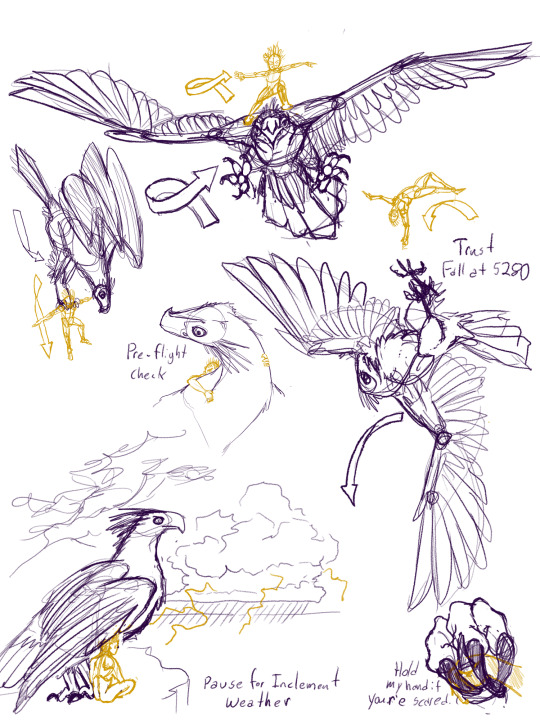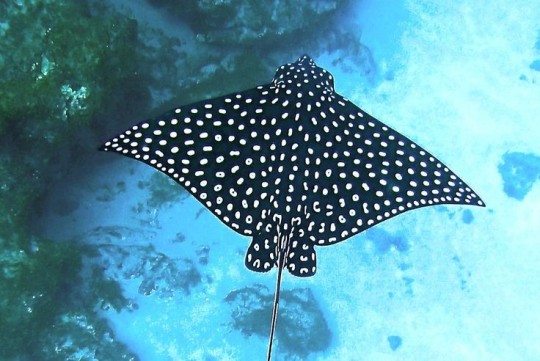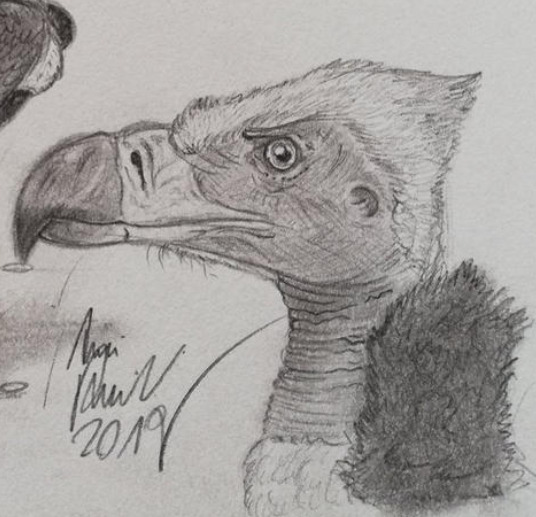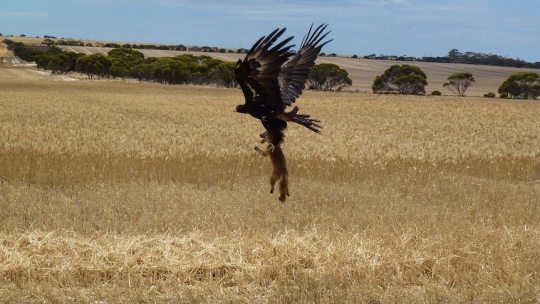#the giant eagles
Text
Te Hōkioi, and Speculation on the Dietary Habits of the Great Eagles
He Hōkioi, i runga, he Hōkioi, i runga, hū.
(The great eagle, from above, made a booming call)
Kei te āputa koe, nā, o te rangi, e noho ana,
(In the open space, there, in the sky, it dwells)
Te hoa moenga, nō whatitiri mātakataka;
(Death's companion, with crashing thunder)
Hei aha, tērā, e tararua mārire, ona hikumaro?
(Why, then, do its tail feathers no longer split the quiet in two?)
Rua maro tonu, ona hakikau;
(Two fathoms wide, its wings;)
E huhū nei, i runga te rangi,
(It called, above in the sky)
Hōkioi, Hōkioi.
(The sound: hōkioi, hōkioi.)
- poem/chant by the great Ngāti Toa chief Te Rauparaha
For @tolkienofcolourweek, I'm spending seven days bringing Māoritanga and mātauranga Māori to the world of Tolkien! Starting off on day 1 with: what did Manwë's Eagles eat?
Such massive animals, especially flying ones, would have required a huge caloric intake. We have little evidence about what potential prey may have existed in Beleriand and Middle Earth. The Hobbit mentions them eating sheep, and it seems likely that they would hunt other large animals, such as deer or bison. But there's nothing in our modern world that compares to or fills an ecological niche like Manwë's Eagles.
This is where I draw on Māori oral history of the largest eagles to ever live.
In English they're called Haast's Eagles, but in Māori there are several names. Probably the most well-known of the Māori names is pouakai/poukai, but my people called them hōkioi.
They were massive, weighing as much as 17.8 kg (about 39 lbs) and with wingspans as large as 3 metres (about 10ft). Their feet and claws were the size of modern day tigers, capable of punching through bone. They hunted prey more than fifteen times their own size.
(Granted, the eagles of Manwë are much larger than even the hōkioi! Still, it's similar enough for me to draw inspiration.)


[Left image: an artist's rendition of a hōkioi perched on a rock. Right image: an artist's rendition of a hōkioi attacking the neck of a giant flightless bird.]
The hōkioi's primary prey was the moa, large flightless birds similar to ostriches or emus. With no large land mammals on the islands, hōkioi were the apex predators.
Then, circa 900 CE, large mammals came to Aotearoa for the first time. They also preyed on moa, reducing the hōkioi's food supply. So perhaps it was natural that the hōkioi began to hunt these mammals as new prey.
Unfortunately, those mammals were us.


[Left image: an artist's rendition of a hōkioi attacking a Māori man who holds a spear. Right image: an artist's rendition of a child running from a hōkioi.]
Our stories of the hōkioi, or pouakai, tell of giant birds that could swoop down from the sky to kill and eat even strong warriors. They were also known to carry off small children.
I'm not saying that the eagles of Manwë ate elves or humans. (I think they were probably given firm instructions not to!) It would make sense for them to prey on orcs and other creatures of Morgoth, though. And there's one other group who we know were hunted like animals in Beleriand, due to... misunderstandings. A group who the Eagles may not have initially recognized as sentient creatures. A group who would have been an ideal size to pick up and carry off as a snack.
I'm just saying, I think there may have been multiple reasons that dwarves chose to live underground.
-
(Sources for further information about te hōkioi:
The man-killer that fell from the sky
NZ Birds: Haast's Eagle)
#silmarillion#silm meta#the giant eagles#tocweek2023#māori-fying tolkien#mine#yes this is a little bit cracky#i fully acknowledge that#so please don't be weird in my notes and inbox#(also i SWEAR i haven't forgotten about my wips and i promise i'm working on them!)
79 notes
·
View notes
Text
soooo i made geoguessr out of the hermitcraft season 8 download
7K notes
·
View notes
Note
What do you think Casey Jr would be for Halloween?
Mandalorian probably?
#or..idk#someone cool from the Star Wars#this dude has zero knowledge about pop culture#so it would definitely be something little turtles showed him#do they even have star wars.....#they have Jupiter Jim so I guess they would absolutely love star wars too haha#Mikey would suggest the lord of the rings#but i think Casey would be the#uh#that one guy who's like#they haD THOSE GIANT EAGLES
538 notes
·
View notes
Text

giant eagle near the rosymorn monastery is a bloodweaver confirmed
#i too use gale on astarion#ajsjdjsjjs just to be clear this is an action the giant eagle can take but i thought this was funny#baldur's gate 3#bg3#bloodweave#kinda?#pic#vg#post.text()
262 notes
·
View notes
Photo

Out of the Frying Pan, into the Fire by Donato Giancola
#fantasy art#fantasy#concept art#digital art#art#lord of the rings#lord of the rings art#lotr#lotr art#middle earth#the hobbit#giant eagle#rescue#hobbit#dwarf#halfling#forest#forest fire#donato giancola
361 notes
·
View notes
Text
okay i have like a billion aus where Nico gets wings for Reasons (because why not. they'd 100% fit his aesthetic) but anyways i am once again thinking about Nico getting wings somehow and Jason teaching him how to fly thank you for coming to my ted talk
#pjo#riordanverse#nico di angelo#jason grace#i also like to hc Jason grew up with his foster family keeping birds#so besides just the giant eagles at CJ he has a lot of personal experience caring for birds#so Nico gets wings and is just floundering with them and Jason is just chasing after him like ''LET ME HELP YOU''#''PLEASE PREEN YOUR WINGS NICO I WILL DO IT FOR YOU I SWEAR-''
241 notes
·
View notes
Text

Sketches of Baby AEIWAM Zaraki getting Flying lessons from his Mom.
Her Human Son may not have adequate feathers to take off on his own just yet, but she isn't about to slack off and let him grow up without the knowledge of what to do when they do grow in.
#AEIWAM#An Elephant Is Warm And Mushy#'Zaraki Kenpachi was raised by giant eagles' started off as a Joke but now it's a vital part of this AU#also an explanation of why his hair is Like That#he does get wings eventually and it's REALLY GOOD he got those lessons because he needs them in a hurry#bleach#bleach fanfic#kenpachi zaraki#zaraki kenpachi#really proud of that anvilhead thunderstorm too
323 notes
·
View notes
Text

Giant Eagle by Darrell K Sweet
#Lord of the Rings#LotR#The Hobbit#Giant Eagle#Middle Earth#Gandalf the Grey#Fantasy#Art#Darrell K Sweet
24 notes
·
View notes
Note
hello!! what’s your favorite kind of stingray
Hi! 😊 Thank you for your ask! *For my other followers, please don't hesitate to send asks! I will answer anything to my best ability, if you have questions!*
My two favorite types of rays are the Giant Oceanic Manta Ray and the Spotted Eagle Ray I've snorkeled with eagle rays before and it's a very fond memory for me! They are absolutely stunning!!


#ask#question#shark blog#stingrays#rays#giant oceanic manta ray#manta ray#spotted eagle ray#eagle ray
34 notes
·
View notes
Text

Might be time to roll up a new party member (Adventurer 1, Robin Parry cover art, April 1986). Looking closely, the water forms a pentagram and the gazebo-like structure on the bank casts a reflection resembling a skull. Is this a very early reference to the dread gazebo? The timing seems unlikely, but the image invites speculation about what is going on in this odd landscape.
#Adventurer magazine#Robin Parry#fantasy#D&D#Dungeons and Dragons#dnd#fantasy art#Mersey Leisure Publishing#1980s#dread gazebo#skull mountain#archer#giant eagle#roc#mountains#river#camel
129 notes
·
View notes
Text

A 20-40 foot (6-12 m) scheming tentacle creature with mind-control slime, telepathy, and a hatred of the gods. They're known for psychic powers, manipulating your emotions or learning your greatest desires.
The giant eagle on the other hand, is a really big bird. It knows 3 languages and has 8 int, so it is sentient! But otherwise Just a 10 foot (3 m) tall bird with a 20 foot (6.1 m) wingspan.
45 notes
·
View notes
Text
Now Teloriel gets to be on top ;3


This was really fun to draw uwu
#teloriel#falmer#snow elf#ocs#giant eagle#rossthren-art-2023#tes#tesblr#skyrim#skyrim art#tes art#digital art
22 notes
·
View notes
Text
Dynatoaetus: Australia's Mighty Eagle
Paleontology news from the land down under, and big ones this time. How big? Well how about one of the largest true birds of prey of Australasia.
Today a new paper was published naming Dynatoaetus gaffae (Gaff's Mighty Eagle), the largest known bird of prey to have ever existed in Australia. Twice the weight of the modern wedge-tailed eagle, it must have been truly an imposing animal to behold, in the Australasian realm second only to the enormous Haast's eagle of New Zealand.
Comparisson below by Ellen K. Mather

But the name is a bit of a missnomer, well sorta. You see, while its referred to as an eagle, phylogenetic analysis shows that the closest living relatives of Dynatoaetus are actually aegypiine vultures. Or in simpler terms, those old world vultures known for their mostly naked necks such as lapett-faced vultures, hooded vultures and griffon vultures. Below some examples of this group by yours truly.



At the same time tho, despite being related to these vultures, Dynatoaetus didn't act like one. In this regard eagle is an appropriate term, more indicative of a lifestyle and morphology rather than relation (seeing as sea eagles relate to kites and philippine eagles are closer to these vultures than "real" eagles). With really robust hindlimbs and powerful talons, Dynatoaetus is more suited to capturing and incapacitating struggling live prey than it is to simply scavening dead bodies. And with Australia's megafauna offering a wide range of kangaroos, giant wombats and flightless birds it hat a lot to choose from.
Of course a bird of this size would not be above scavening either and with its power and bulk it could easily dominate carcasses when in conflict with the smaller Cryptogyps. Overall this lifestyle appears similar to what we see today in wedge-tailed eagles, which are formidable hunters but also opportunistic scavengers. Mather and colleagues even go as far as to suggest that the role of generalist apex predator was initially filled by Dynatoaetus and wedge-tails only managed to take up this nische after the former went extinct some 50k years ago along with most of Australias native fauna.
If you want an idea of things, here's some pictures of wedge-tailed eagles doing their thing. Now imagine what that would be like at twice the size.
images by Clive Roper and Scott Bell


As per usual with these posts, here is the Wikipedia page I set up. Keep in mind the skeletal there shows the known material, but does not accurately represent the real proportions as its simply a colored griffon vulture. And the paper itself, its open access and gives more detail than I ever could.
Dynatoaetus - Wikipedia
A giant raptor (Aves: Accipitridae) from the Pleistocene of southern Australia | SpringerLink
And since you made it this far, here's a reward....or punishment? Idk depends but once I heard its name meant "mighty eagle" I couldn't get this goddamn clip out of my head and so you shall suffer with me.
#paleontology#palaeblr#eagle#birds of prey#vulture#Dynatoaetus#pleistocene#australia#giant eagle#fossil#prehistory#extinct animals#wedge tailed eagle
93 notes
·
View notes
Text

Behold the awesomeness that is the poster for The Magic Serpent (1966)!
#The Magic Serpent#Jiraiya#Ikazuchi-Maru#Orochimaru#Dojin Hiki#Tsunade#water-spewing dragon#giant fire-breathing toad#giant eagle#giant spider#samurai#ronin#Toei#tokusatsu#kaiju
37 notes
·
View notes

